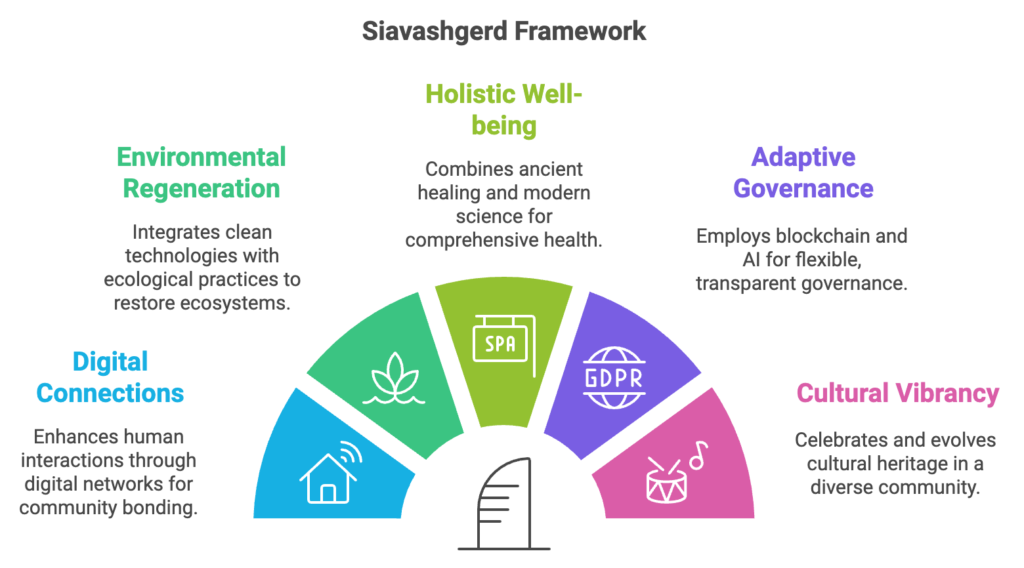Preface : A Vision Grounded in Science
In the heart of an ancient Persian legend lies a seed of wisdom that, I believe, holds the key to reimagining our future. The story of Siavash and his legendary city, Siavashgerd, has long captivated my imagination, not merely as a tale of the past, but as a beacon for what our communities could become.
As an entrepreneur with roots in Persian culture and a deep interest in the intersection of tradition and innovation, I found myself increasingly troubled by the disconnect I observed in our modern urban environments. The very cities that promised progress and connection seemed to be breeding grounds for isolation and environmental degradation. This paradox led me on a journey—one that would bridge millennia of human wisdom with the cutting edge of scientific discovery.
Siavashgerd, as I envision it, is not just a concept but a call to action. It’s a framework for creating communities that honor our ancestral knowledge while harnessing the unprecedented power of modern technology. But vision alone is not enough. In developing this idea, I realized the critical importance of grounding these aspirations in rigorous scientific inquiry.
This book is the result of years of research, collaboration with experts across diverse fields, and a commitment to bridging the gap between ancient wisdom and empirical evidence. It presents Siavashgerd not as a utopian fantasy, but as a practical, evolving model for community development—one that is open to scrutiny, adaptation, and continuous improvement.
As you read, you’ll encounter a blend of inspirational ideas and hard data, visionary concepts and scientific methodologies. My hope is that this work will not only illuminate a path forward for our urban communities but will also inspire a new wave of interdisciplinary collaboration in tackling the complex challenges of our time.
Siavashgerd is more than a tribute to a legendary city; it’s a roadmap for creating the harmonious, sustainable communities we desperately need in our rapidly changing world. Join me on this journey of discovery, where the echoes of ancient wisdom meet the rigors of modern science, pointing the way to a more connected, sustainable, and fulfilling urban future.

Introduction: Reimagining Community in the Digital Age
The Crisis of Modern Urban Living: A Statistical Overview
As we stand on the brink of a new decade, the promise of our cities as hubs of innovation and human connection is being severely tested. The statistics paint a stark picture of the challenges we face:
- Loneliness and Social Isolation:
- A 2020 survey by Cigna found that 61% of Americans report feeling lonely, a 7% increase from 2018.
- In the UK, over 9 million people often or always feel lonely, costing employers up to £2.5 billion annually due to reduced productivity (Campaign to End Loneliness, 2020).
- Mental Health:
- Depression rates in urban areas are 20% higher than in rural areas (WHO, 2019).
- Anxiety disorders affect 284 million people worldwide, with higher prevalence in urbanized nations (Our World in Data, 2018).
- Environmental Degradation:
- Cities occupy just 3% of the Earth’s land but account for 60-80% of energy consumption and 75% of carbon emissions (UN Habitat).
- Urban areas are losing green spaces at an alarming rate, with a 20% decline in urban tree cover in the US over the past 10 years (US Forest Service, 2018).
- Community Cohesion:
- Only 31% of Americans say they know their neighbors well (Pew Research Center, 2019).
- Civic participation has declined by 45% since the 1960s in most developed nations (Harvard Kennedy School, 2020).
These figures underscore a paradox: our cities, more connected than ever through technology, are failing to meet our fundamental human needs for connection, well-being, and harmony with our environment.

The Potential of Integrating Ancient Wisdom with Futuristic Technology
The solution to our modern dilemma may lie in an unlikely fusion – the marriage of ancient wisdom with cutting-edge technology. Throughout history, human societies have developed profound insights into the art of communal living, the rhythms of nature, and the balance of individual and collective needs. When viewed through the lens of our technological capabilities, these timeless principles offer a roadmap to a more harmonious future:
- Collective Decision-Making: Ancient practices of community councils can be enhanced by blockchain technology and AI-driven consensus tools, enabling transparent and participatory governance at scale.
- Sustainable Resource Management: Traditional knowledge of ecological stewardship can be amplified by IoT sensors and smart resource management systems, optimizing our use of energy, water, and materials.
- Social Cohesion: Age-old techniques for fostering human connection can be supported and expanded through virtual and augmented reality platforms, creating new forms of community engagement that transcend physical limitations.
- Holistic Well-being: Ancient healing practices and holistic health approaches can be integrated with modern medical science and wearable technology, creating comprehensive health ecosystems within our communities.
- Regenerative Design: Biomimetic principles inspired by nature’s time-tested patterns can be realized through advanced manufacturing techniques and materials science, creating built environments that are both highly efficient and deeply attuned to natural systems.

Introducing Siavashgerd: A New Paradigm for Harmonious Communities
Siavashgerd represents a bold reimagining of urban life – a synthesis of timeless wisdom and futuristic innovation. Named after the legendary city of Persian mythology, Siavashgerd is not just a physical blueprint but a comprehensive framework for community development that addresses the core challenges of our time:
- Connection in the Digital Age: Siavashgerd communities are designed to foster deep human connections while leveraging the power of digital networks, creating a new model of “phygital” interaction that combines the best of both worlds.
- Environmental Regeneration: By integrating advanced clean technologies with traditional ecological knowledge, Siavashgerd aims to create urban environments that are not just sustainable, but actively regenerative – improving the health of local ecosystems.
- Holistic Well-being: Siavashgerd’s approach to health and wellness draws from both ancient healing traditions and cutting-edge medical science, supported by ambient technology that promotes physical, mental, and social well-being.
- Adaptive Governance: Utilizing blockchain and AI, Siavashgerd communities implement flexible, participatory governance models that can rapidly adapt to changing needs while ensuring transparency and equitable representation.
- Cultural Vibrancy: Siavashgerd celebrates cultural heritage while embracing global diversity, creating spaces and systems that allow for the preservation and evolution of cultural practices in a harmonious, shared environment.

The Scientific Approach to Developing Siavashgerd
While rooted in ancient wisdom and visionary thinking, the development of Siavashgerd is firmly grounded in scientific methodology:
- Interdisciplinary Collaboration: The Siavashgerd model has been developed through collaboration with experts in urban planning, environmental science, sociology, psychology, computer science, and more, ensuring a comprehensive, systems-based approach.
- Data-Driven Design: Every aspect of Siavashgerd is informed by rigorous data analysis, from studying successful historical community models to running complex simulations of proposed systems.
- Empirical Testing: Key components of the Siavashgerd model are being tested in small-scale pilot projects, allowing for the collection of real-world data and continuous refinement of the concept.
- Adaptive Framework: Rather than a fixed blueprint, Siavashgerd is designed as an adaptive framework, with built-in mechanisms for ongoing research, feedback loops, and iterative improvement.
- Open Collaboration: The development of Siavashgerd embraces open-source principles, inviting scrutiny, contribution, and adaptation from a global community of researchers, practitioners, and citizens.
As we delve deeper into the Siavashgerd model in the following chapters, we will explore how this scientific approach informs every aspect of its design, from the layout of physical spaces to the algorithms governing its digital systems. We’ll examine case studies, analyze data, and critically evaluate the potential and challenges of implementing Siavashgerd principles at various scales.
The journey ahead is both exciting and daunting. It calls for a fundamental rethinking of how we design, build, and live in our urban environments. But in the synthesis of ancient wisdom and modern science, in the balance of technological power and human-centered design, lies the potential to create communities that don’t just survive the challenges of our time, but thrive in harmony with each other and the natural world.
Welcome to Siavashgerd – a vision for the future, rooted in the past, and rigorously developed for the present. Let us embark on this exploration together, with open minds, critical thinking, and a shared commitment to reimagining the very fabric of our communal life.

